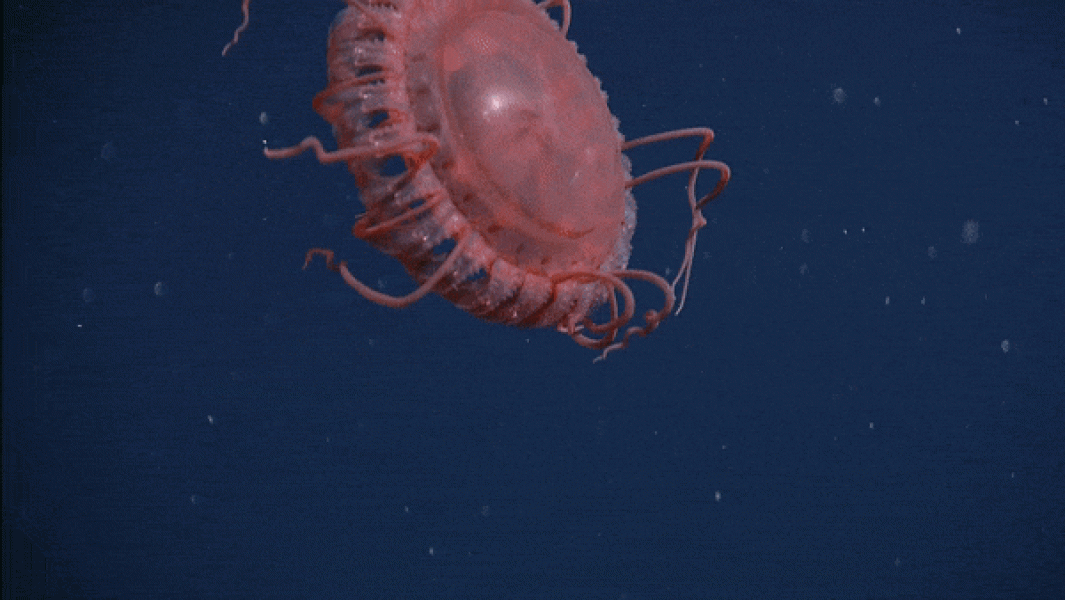
The newly discovered Atoll jellyfish has coiled tentacles. (Photo credit: Matsumoto et al., Animals 2022 / MBARI / CC BY 4.0)
Researchers have found a new species of crown jellyfish that resembles a red alien saucer in the dark “midnight zone” of Monterey Bay, California.
The newly described species, Atolla reynoldsi, measures about 5 inches (13 centimeters) in diameter and can have between 26 and 39 tentacles, according to scientists at the Monterey Bay Aquarium Research Institute (MBARI). Like the 10 other known species in the genus Atolla, A. reynoldsi has a deep groove surrounding its central bell, giving its body the appearance of a domed head topped by a red crown of fins.
Despite being barely wider than a dollar bill, A. reynoldsi is likely the largest known species of Atoll jellyfish, the researchers say. However, what really sets this jellyfish apart from its relatives is what it lacks; unlike all other known species of crown jellyfish, A. reynoldsi lacks one elongate tentacle—a long, thin appendage that extends behind its body and is six times the diameter of the jellyfish’s bell.
According to the researchers, the crown jellyfish uses this elongated appendage to catch prey, including crustaceans, siphonophores (rope-like animals) and other small organisms that pass through the ocean's midnight zone – a deep, sunless region of the ocean found between 3,300 and 13,100 feet (1,000 and 4,000 m) below the surface.
While analyzing thousands of hours of video footage taken in Monterey Bay's Midnight Zone from April 2006 to June 2021, MBARI scientists occasionally spotted jellyfish that lacked their signature elongated tentacle. The team suspected they had discovered three new species of jellyfish in the bay, but the sightings were too infrequent to confirm.
In a new study published March 16 in the journal Animals, researchers have definitively identified one of the unknown jellyfish as a new species, A. reynoldsi. The team analyzed 10 specimens of the enigmatic crown jellyfish, including both physical samples and observations from archival records, to conclude that the species is “molecularly and morphologically distinct” from all other known species in the genus — meaning it is both physically and genetically distinct from its relatives.
To date, A. reynoldsi has only been spotted in Monterey Bay, where it lives at depths ranging from 3,323 to 10,463 feet (1,013 to 3,189 m).
“These amazing new jellyfish highlight how much we still have to learn about the deep ocean,” said lead author George Matsumoto, a senior education and research specialist at MBARI. “Almost every time we dive into the depths of Monterey Bay, we discover something new.”
MBARI researchers have discovered more than 225 new species in the past 34 years, according to the institute. Two other jellyfish species that lack tentacles may well be classified as new Atolla species in the future, the scientists added, although more observations are still needed.
Originally published on Live Science.

Brandon SpectorSocial LinksNavigationEditor
Brandon is the Space/Physics Editor at Live Science. His work has appeared in The Washington Post, Reader's Digest, CBS.com, the Richard Dawkins Foundation, and elsewhere. He holds a BA in Creative Writing from the University of Arizona, with minors in Journalism and Media Arts. He enjoys writing about space, geoscience, and the mysteries of the universe.
Sourse: www.livescience.com





